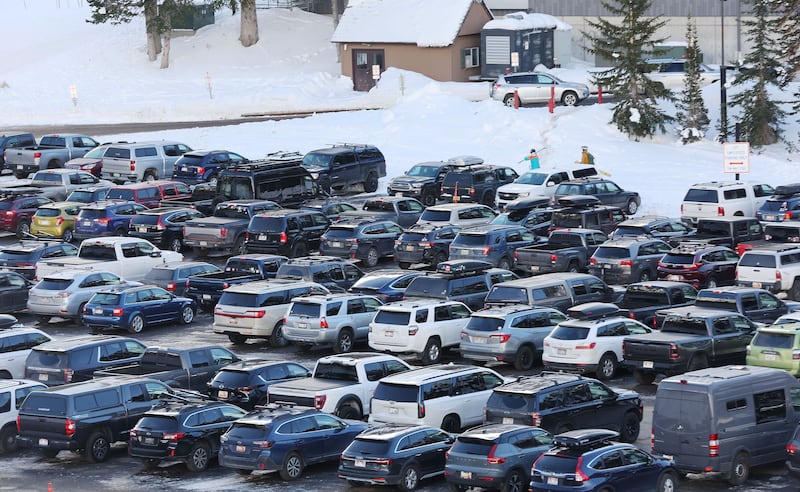Utahns are divided over whether or not the state should build a gondola to take skiers to Snowbird and Alta. Some will do anything to cut the traffic, others want only to preserve the canyon.
Students for the Wasatch is an inherently anti-gondola organization, but the group of University of Utah students invited pro-gondola representatives to talk to students Monday night.
“It’s important for the audience to hear from both sides so that they’re able to form their own opinions and develop their own ideas,” Students for the Wasatch vice president Maddie Stagg said.
Although most of the audience in the packed conference room already opposed the gondola, they listened civilly as Utah Department of Transportation project manager Josh Van Jura and Snowbird general manager Dave Fields made the case for it.
“Most of the audience was not agreeing with what they were saying, so I think they handled things well,” event attendee Kate Ambler said of the two pro-gondola speakers. However, the occasional muttering in the audience and probing questions submitted in the Q&A session hinted at listeners’ lingering skepticism.
“I think, if anything, those people who were on the fence became more educated and they learned the steps to take action,” Stagg said.
Ambler works as a Mountain School instructor at Snowbird and used to take the bus from 6200 South and Wasatch Boulevard to work until the Utah Transit Authority discontinued the route this season. She said it was frustrating to hear Van Jura and Fields talk about new solutions when existing options are being cut.
“Their whole thing is to get more people up the canyon. And then they are cutting buses because they don’t have enough drivers, but they have funding for a gondola.”
After the discussion, Students for the Wasatch co-founder Claudia Weise urged the audience toward the “action table,” where they could write their opinions in letters to the Wasatch Front Regional Council and state legislators.
The case for the gondola
Van Jura and Fields maintain the gondola is the best option to reduce the traffic that overwhelms Little Cottonwood Canyon.
To illustrate the concern, Fields shared a text he recently received: “I left my house at 7:30. I’m four hours in and still 35 minutes away from Alta.” He also talked about residents who live in and around Little Cottonwood Canyon being trapped in their homes on busy ski days.
Fields emphasized that this congestion is more than an inconvenience — it’s a matter of safety. Lines of idling cars create pollution and could potentially obstruct emergency vehicles.
Van Jura said these problems are projected to get worse with population growth. “In 2050, there will be about 50 days a year on which it will take 80 or more minutes to get up the canyon, as opposed to 20 minutes now,” he said.

Fields addressed funding concerns, saying it’s possible that the project will not be completely funded by taxpayers.
“In my conversations with the federal delegation that represents Utah, I’ve also seen a lot of interest and their willingness to try to get federal dollars to help support it,” he said.
He also talked about public opinion, saying that in one poll, when those who preferred buses over the gondola were asked if they would take the bus, they said no.
Van Jura said that although the goal was to make a decision by the end of this winter, they will consider public opinion, even if it means not making the deadline.
The case against the gondola
Students for the Wasatch president Emily Pitsch opposes the gondola because she believes it would be ineffective in reducing traffic, unnecessarily expensive and dangerous to the environment.
She pointed out holes she sees in the plan, like a lack of bus services to the gondola base and the fact that it would only lead to ski resorts, leaving no public transit to anywhere else in the canyon.
Pitsch also said the gondola project would aim to increase ski resort attendance. “Honestly, I don’t understand how we can reduce traffic by UDOT’s goal of 30% while simultaneously increasing the capacity of the ski resorts,” she said.
The economic benefit resorts could get from the gondola calls the project’s aims into question, according to Pitsch.
“I’d like to ask the question of what solutions would the resort pursue if they had to pay for this?” she said.
Instead, Pitsch said, the financial burden — recently estimated by the Wasatch Front Regional Council to be $1.4 billion — is likely to fall on the shoulders of taxpayers. Salt Lake County Mayor Jenny Wilson, who attended the discussion, said this would be unfair.
“It doesn’t seem fair to me that a kid in rural Utah who will never come to our county, let alone go up that canyon, is going to pay for part of this,” Wilson said, eliciting snaps from the audience.
Pitsch also expressed concern for the canyon’s watershed, saying both the Salt Lake Department of Public Utilities and the Metropolitan Water District of Salt Lake and Sandy have done the same.
The gondola would also damage the beauty of the landscape, Pitsch said. There would likely be 22 towers in the canyon, the tallest of which would be 262 feet. She compared this to the 285-foot Utah Capitol.
“So next time you look up at Capitol Hill, think about that in your canyon,” Pitsch said.
Finally, Pitsch presented alternative solutions, which included parking reservations at Snowbird, carpooling incentives and an improved electric bus system.
Sandy Mayor Monica Zoltanski echoed the call for solutions other than a gondola and issued a plea for civic engagement.
“It’s not enough to just say no, we don’t want the gondola,” Zoltanski said. “But with some basic consumer behavior modification, some more buy-in from the resorts, frankly, and cultivating good ideas that are right here in this room tonight, we can meet that 30% traffic reduction.”


